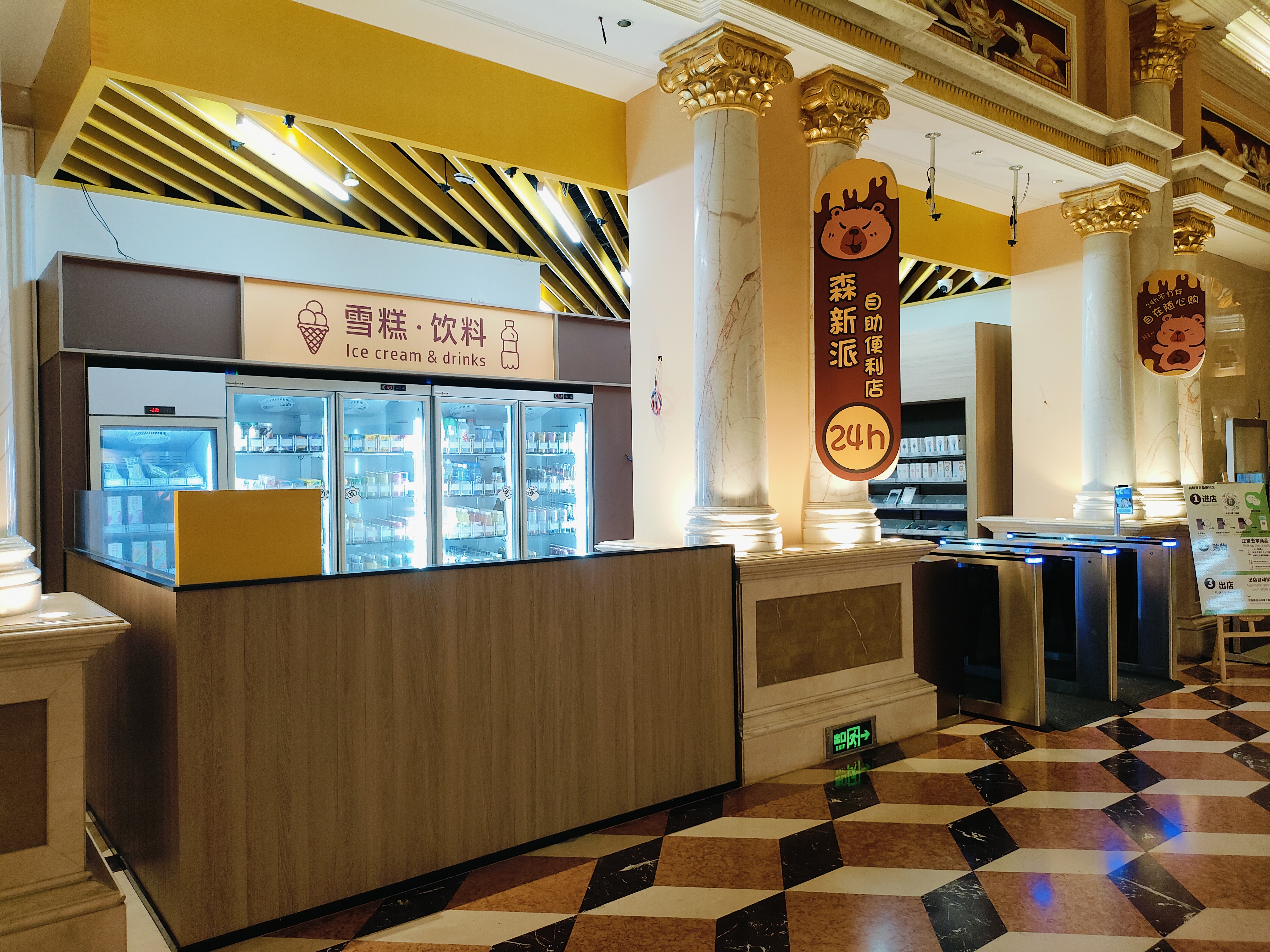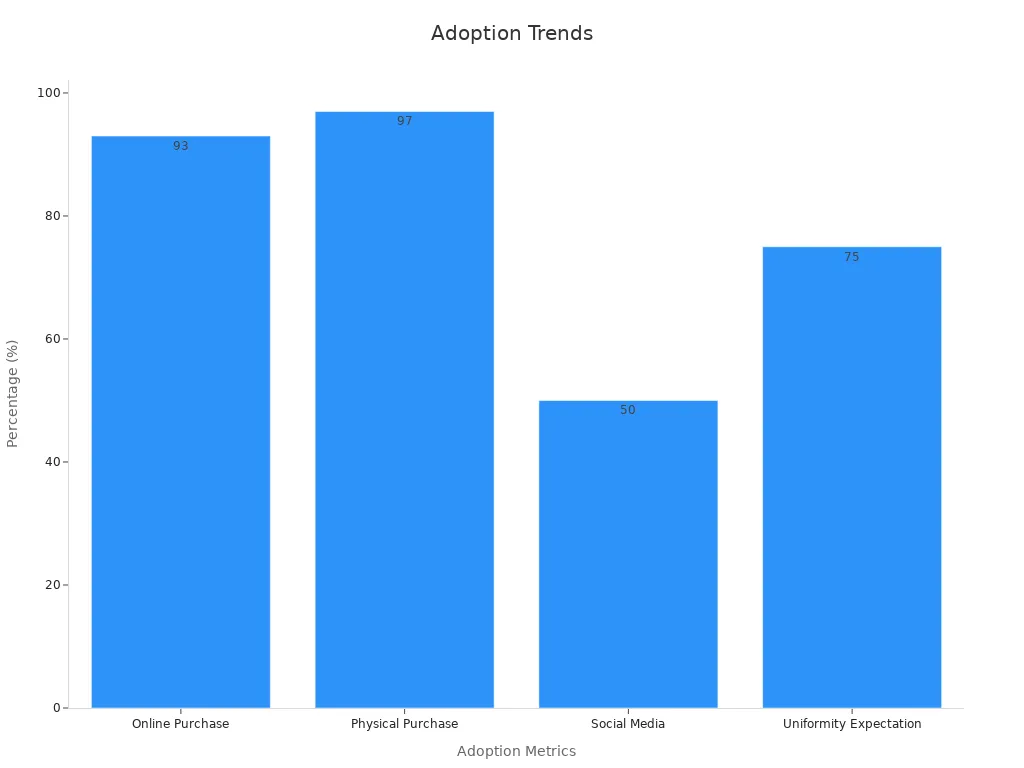Electric Shopping Carts: Features, Benefits, and Technology for Modern Retail

Imagine walking into a store and seeing a smart cart ready to help you shop. You grab an electric shopping cart and instantly feel the convenience as it glides across the floor, making the shopping experience smoother. Smart shopping carts now use advanced technology to boost your independence and convenience. These carts have grown in popularity, especially in large Western supermarkets.
Market trends show electric shopping carts reached a market size of $75.74 million in 2024 and smart shopping carts soared to $1.77 billion in 2023.
Smart carts now offer real-time navigation, product scanning, and seamless checkout, changing your experience into a revolution of convenience and efficiency.

Key Takeaways
Electric shopping carts use motors and smart technology to make shopping easier, especially for people with mobility challenges.
Smart carts include features like GPS, barcode scanners, touchscreens, and AI to help you find products, scan items, and pay quickly.
Safety systems like automatic brakes and sensors protect shoppers and reduce accidents in stores.
Smart shopping carts connect to the internet and store systems, allowing real-time billing, inventory tracking, and personalized shopping experiences.
Future shopping carts will be autonomous, using AI to navigate stores and offer hands-free shopping, improving convenience and efficiency.
Electric Shopping Carts in Retail
What Are Electric Shopping Carts?
You see electric shopping carts in many retail stores today. These carts use electric motors to help you move around the store with less effort. You control the cart with simple buttons or a joystick. Electric shopping carts make shopping easier for everyone, especially if you have trouble walking or standing for long periods. In the smart shopping cart market, these carts now include features like GPS, barcode scanners, and touchscreens. You can scan items, check prices, and even pay right from the cart. This technology helps you shop faster and more independently.
Traditional carts started as metal frames with wheels. Over time, stores switched to plastic carts for better comfort and easier repairs. Now, electric shopping carts have changed the smart shopping cart market by adding digital tools. These carts connect to store systems, track inventory, and help you find products. The smart shopping cart market keeps growing as more stores want to improve your shopping experience.
Types and Designs
You will find many types of electric shopping carts in the smart shopping cart market. Some carts are basic, with just a motor and a seat. Others have advanced features like adjustable seating, extra storage, and digital displays. The smart shopping cart market also offers foldable carts for easy storage and transport. Many carts now use ergonomic designs to keep you comfortable during your trip.
Here are some common features you might see in the smart shopping cart market:
GPS tracking for easy navigation in large retail stores
App connectivity for shopping lists and deals
Safety features like automatic braking and collision sensors
Touchscreen displays for product information and checkout
Eco-friendly materials for sustainability
Retailers in the smart shopping cart market focus on making carts safer, more comfortable, and easier to use. Leading brands invest in research to add new technology, such as AI-powered vision systems and IoT connectivity. These changes help you shop with more confidence and make retail environments more welcoming for everyone.
Note: The smart shopping cart market grows as more people want convenience, safety, and better shopping experiences. Retailers in Europe, the UK, and other regions now use electric shopping carts to support elderly and disabled shoppers, showing a strong commitment to accessibility.
Key Features

Intelligent Controls
You control the cart with easy-to-use buttons or a joystick. Modern technology lets the cart adjust its power based on your speed, the weight you carry, and the surface you drive on. The cart’s intelligent system talks to the motor and transaxle, making sure you get smooth movement and better control. Some carts use computer-controlled transmissions and smart differential systems. These features help you move around the store with less effort and more comfort.
Performance Metric | Description |
|---|---|
Efficiency | Measures how well the motor’s power moves the cart, showing how much energy you save. |
Durability | Checks if the cart’s parts last a long time without breaking. |
Weight Distribution | Looks at how the cart spreads weight across the wheels for better balance and easy turning. |
Noise Level | Shows how quiet the cart is, making your shopping trip more pleasant. |
This technology makes your shopping trip easier and more enjoyable.
Safety Systems
Safety comes first when you use an electric cart. Stores use advanced technology to keep you safe. Many carts have automatic brakes, collision sensors, and alarms. These systems help prevent accidents and protect you and others.
Deloitte found that better training and new policies lowered injury rates in stores.
Machine learning can predict accidents with 78% accuracy, so stores can stop problems before they happen.
Safety systems use big data to help managers make better choices and keep everyone safe.
Factor | Impact on Safety Performance Index (Weight) |
|---|---|
Organizational | |
Environmental | 0.209 (Lowest impact) |
You can trust that the cart’s safety features work hard to protect you.
Battery and Drive
The cart’s battery and drive system give you the power to shop longer. Most carts use batteries with a 35 Amp-Hr capacity, almost double the old standard. You can use the cart for 6-8 hours before it needs a recharge. The motor gives 400 watts of power, so the cart can move smoothly, even with a full load. The drive system uses a strong transaxle and a gear ratio of 18:01. Some carts can reach speeds up to 7 mph, but you control the speed for safety.
Feature | Benchmark/Specification |
|---|---|
Battery Life | 35 Amp-Hr |
Operating Time | 6-8 hours |
Motor Power | 400 watts at 24V |
Drive System | Single reduction open differential transaxle |
Gear Ratio | 18:01 |
Maximum Speed | Up to 7.0 mph |
With this technology, you can rely on your cart to last through your entire shopping trip.
Smart Shopping Carts Technology

Smart shopping carts use advanced technology to change how you shop in smart stores. These carts combine sensors, cameras, artificial intelligence, and IoT connectivity to make your experience smoother and more efficient. You can see how these smart retail technologies help with automated checkout, real-time inventory tracking, and digital payments. Let’s explore how each part works together to create a smarter shopping journey.
Sensors and Cameras
You interact with smart shopping carts that use many types of sensors and cameras. These devices help the cart know what you put inside and keep track of your items. You find stereo cameras, time-of-flight sensors, ultrasonic sensors, radar, and lidar in these carts. Each sensor has a special job:
Stereo cameras sit about 20 to 50 centimeters apart. They help the cart see depth and create 3D images of your basket.
Time-of-flight sensors send out light pulses and measure how long they take to return. This helps the cart know how far away things are.
Ultrasonic sensors work at high frequencies, above 100 kHz. They detect if you add or remove items and help the cart understand the shape of what’s inside.
Cameras have wide fields of view, usually between 60° and 120°, so they can see everything in your basket.
Some carts use vibration sensors or weight scales to trigger the cameras when you place an item inside.
Smart shopping carts also use barcode scanners and touch screens. You scan each product, and the cart’s sensors check the weight and placement. The touchscreen shows your running total, helps you find products, and even gives you recipe ideas. In smart stores, you see kiosks with large touchscreens, barcode scanners, and cameras for self-checkout. These features make shopping faster and help prevent mistakes or theft.
Tip: The combination of sensors and cameras in smart shopping carts helps you enjoy a seamless shopping experience with automated item tracking and real-time updates.
AI and Computer Vision
Artificial intelligence and computer vision play a big role in smart shopping carts. When you add an item, the cart uses AI to recognize the product and update your bill. This technology matches products with about 90% accuracy, making sure your checkout is smooth and fast. You get better service, and the store gets better inventory data.
Metric | Value | Description |
|---|---|---|
Shrink Incident Detection | Over 90% | Finds theft or mistakes in real time |
False Positives | Less than 5% | Keeps errors low, so you don’t get slowed down |
Staff Interventions Reduction | 80% | Lets you shop with less help from store workers |
Smart shopping carts use AI to help you find products, suggest deals, and guide you through the store. You see real-time billing and product recognition, which means you spend less time at checkout. The cart can even help you with navigation, making your trip in smart stores easier. These smart features improve your experience and help stores run better.
IoT and Connectivity
Smart shopping carts connect to the internet and store systems using IoT, or the Internet of Things. This technology lets your cart talk to other devices in smart stores. RFID tags on products help the cart read what you buy without manual scanning. You see your bill update in real time, and the store tracks inventory automatically.
RFID-enabled carts help you skip long lines by automating billing and checkout.
IoT and machine learning give you better product recommendations and help stores learn what shoppers like.
Cloud and fog computing make sure your data moves quickly and safely, even when the store is busy.
RFID tags let the store manage inventory in real time, cutting down on errors and saving time.
Smart shopping carts show you product and billing info as you shop, making digital payments easy and secure.
Advanced routing methods keep the system energy-efficient and fast, even in large smart stores.
Experts predict that by 2025, most smart stores will use RFID and IoT for better shopping and store management.
Note: IoT and RFID in smart shopping carts help stores collect data, improve customer service, and make shopping more fun and efficient.
Smart shopping carts bring together sensors, AI, and IoT to create a powerful tool for smart stores. You get faster checkout, better product suggestions, and a more enjoyable shopping trip. Stores benefit from real-time inventory tracking, less manual work, and more insights into what customers want. As smart retail technologies grow, you will see even more improvements in how you shop and pay.
Customer Experience
Accessibility and Independence
You gain more independence when you use smart shopping carts. These carts help you move through the store with ease, even if you have mobility challenges. You control the cart with simple buttons, so you do not need to rely on others. Many stores design their carts to support all customers, making the shopping experience more inclusive. You feel confident and comfortable, which leads to an enhanced customer experience. When you can shop on your own, you enjoy greater convenience and freedom.
Enhanced Shopping Experience
Smart shopping carts transform your shopping experience by making every step easier. You save time because the cart helps you scan items, check prices, and pay without waiting in line. This time-saving feature increases your convenience and enjoyment. At Shanghai Pudong International Airport, travelers use AI-powered carts that boost convenience and improve store efficiency. Surveys show that clear instructions and easy-to-use carts increase customer satisfaction and trust. You find that convenience, enjoyment, and value motivate you to keep using these carts.
Metric | Description |
|---|---|
Shows how much you spend, reflecting engagement and effectiveness of smart carts. | |
Customer Retention Rate | Measures how many customers return, showing satisfaction and loyalty. |
Churn Rate | Tracks customers leaving; a low churn means strong satisfaction. |
Customer Lifetime Value | Represents total expected revenue from a customer, showing long-term value and loyalty. |
You notice that a seamless shopping experience leads to higher customer satisfaction and an enhanced customer experience.
Smart carts save time and increase shopping value.
You enjoy more convenience and feel motivated to return.
Technology anxiety and compatibility affect your willingness to use smart shopping carts.
Navigation and Assistance
You find items faster with smart shopping carts. These carts offer interactive maps and live updates, guiding you through the store. You spend less time searching and feel less stressed. The cart helps you avoid missing items and makes your shopping experience smoother. You receive real-time assistance, which adds to your enhanced customer experience. Smart shopping carts give you clear directions, so you enjoy a more organized and convenient trip.
Tip: Using smart shopping carts gives you a seamless shopping experience, making every visit easier and more enjoyable.
Retail Benefits
Data and Insights
You gain powerful data and insights when you use smart stores. These stores collect information about what you buy, how you shop, and which products you like. Retailers use this data to understand trends and make better decisions. You help shape the future of retail by sharing your shopping habits. Smart stores use advanced solutions to track every step of your journey. This helps retailers see which products sell best and which need improvement. You benefit because stores can offer more of what you want and less of what you do not need.
Inventory Management
Smart stores use technology to improve inventory management. You see fewer empty shelves and more products in stock. Retailers track inventory turnover rates to measure how quickly products sell and get replaced. For example, a clothing retailer with $90,000 in annual sales and $7,500 in average inventory has a turnover rate of 12. This means the store replaces its stock every month. High turnover rates show that retailers manage inventory well. They also use Gross Margin Return on Investment (GMROI) to check if they make a profit on each dollar spent on inventory. When GMROI is above 1, retailers know their solutions work. Smart stores also track order accuracy, stockout frequency, and customer satisfaction. You get better service because stores use these solutions to keep shelves full and prices fair.
Inventory turnover rate
Order fulfillment accuracy
Stockout frequency
Carrying costs
Customer satisfaction
Lead time reduction
GMROI
These key points show how smart stores use solutions to make retail more efficient for you.
Marketing and Personalization
You experience marketing that feels made just for you in smart stores. Retailers use personalized solutions to recommend products, send special offers, and create shopping experiences that match your interests. Personalized content can boost conversion rates by up to 10%. When you see personalized calls-to-action, you are more likely to buy, sometimes over 200% more. One online retailer saw a 26% jump in revenue after using personalized recommendations. You feel valued when stores remember your preferences. Over half of customers stay loyal to brands that offer personalized experiences, and 44% become repeat buyers. Personalized product suggestions can increase revenue by up to 300%. Upselling and cross-selling with personalized solutions raise your average order value by 10-30%. Brands like Sephora and Nike use personalized marketing to grow sales and keep customers coming back. In smart stores, you enjoy shopping that fits your needs, making retail more rewarding for everyone.
Cost and Safety
Purchase and Maintenance
You may wonder about the cost of electric and smart shopping carts. These carts require an initial investment, but they can save you money over time. You spend less on repairs because modern carts use durable materials and smart designs. Regular maintenance checks help you avoid big problems. You should look for carts with easy-to-replace batteries and simple controls. Many stores choose carts that allow quick cleaning and fast part swaps. This keeps the carts ready for every checkout rush.
Cost Factor | Description |
|---|---|
Initial Purchase | Price of buying new electric or smart carts |
Maintenance | Routine checks, cleaning, and part replacements |
Downtime | Time lost when carts need repairs |
Upgrades | Adding new features or software |
You see that stores often spend more at first but save money by reducing breakdowns and keeping checkout lines moving.
Safety Practices
You play a key role in keeping shopping safe. Stores follow strict safety practices to protect you and their staff. Many stores use machine guarding audits and prepare for new electronic reporting rules. You may notice safety signs and clear walkways near checkout areas. Local safety councils help stores learn the best ways to prevent injuries. OSHA now requires detailed injury data from large stores, which helps improve safety for everyone.
OSHA offers free help to small stores to find and fix hazards.
Stores that invest in safety programs see a return of $2 to $6 for every $1 spent.
New rules require stores with over 100 workers to report injuries electronically.
OSHA increased fines for repeat safety violations, making compliance more important.
Many stores now plan for safety early, especially when adding new technology or automation.
You benefit from these practices because they lower the risk of accidents and keep checkout areas safe and efficient.
Store Policies
You should know that each store sets its own policies for electric and smart carts. Some stores require you to return the cart to a special area after checkout. Others may have staff help you with the cart if you need it. Stores often post clear rules about who can use electric carts and how to operate them safely. You may see reminders to keep aisles clear and to report any problems right away. These policies help everyone enjoy a smooth and safe checkout experience.
Tip: Always follow store instructions and ask for help if you have questions about using electric or smart carts. This keeps your shopping trip safe and stress-free.
Future of Shopping Carts
Autonomous Carts
You will soon see a new revolution in smart stores with autonomous carts. These carts use sensors and AI to move through aisles without your help. You can shop hands-free while the cart follows you or navigates to products on its own. The smart cart market is growing fast because supermarkets and convenience stores want to improve shopping efficiency. North America and Europe lead in adoption, but Asia Pacific will see the highest growth due to e-commerce and automation. You will notice that AI-powered navigation, wireless connectivity, and mobile payment integration drive this trend. Companies like Caper, Veeve, and E-MART already deploy these smart carts in smart stores. The table below shows important trends in the autonomous cart market:
Aspect | Details |
|---|---|
Market Segments | Supermarkets dominate due to high transaction volumes; convenience stores show strong growth. |
Checkout Types | Self-service checkout leads; remote control carts gaining traction. |
Regional Adoption | North America and Europe lead; Asia Pacific expected highest growth due to e-commerce and automation. |
Technological Drivers | AI-powered navigation, wireless connectivity, integration with mobile payments and loyalty programs. |
Challenges | Safety concerns, liability, high initial costs, customer trust issues. |
Growth Catalysts | Government incentives, strategic partnerships, AI and robotics advancements. |
Emerging Trends | AI personalization, biometric payment integration, hybrid online-offline shopping models. |
Leading Companies | Caper, Veeve, E-MART actively deploying autonomous carts. |
Market Outlook | Strong adoption trajectory forecasted for autonomous carts in near future. |
You will experience a revolution in how you shop as these smart carts become more common in smart stores.
Omnichannel Integration
Smart stores now connect your online and in-store experiences. You can scan QR codes on smart carts to get digital coupons or special offers. When you use a smart cart, you help retailers track what you like and buy. This data lets stores send you personalized deals and improve your shopping journey. For example, a grocery chain used QR codes on smart carts to boost coupon redemptions and measure return on investment. A beverage brand combined smart cart ads with online retargeting and saw a 30% higher engagement rate. You will notice that smart stores use unified data analytics to manage inventory and customer service. Some retailers train staff for both online and in-store roles, making your experience seamless. Beauty retailers use smart apps and in-store technology to collect your preferences and offer better service. Smart stores use advanced analytics to match inventory with demand, reducing costs and keeping shelves stocked. You benefit from a smooth, connected experience every time you shop.
Environmental Impact
Smart stores focus on sustainability to protect the environment. You help reduce carbon emissions when you use smart carts made from recycled materials or retrofitted old carts. Smart carts support local shopping and efficient operations, which lowers the carbon footprint. Many smart stores also use carbon-neutral shipping and sustainable packaging. Here are some ways smart carts help the environment:
Nuzest offset over 250,120 pounds of carbon by using sustainable shopping solutions.
Retrofitting old carts instead of making new ones cuts emissions from production.
Local shopping and efficient smart cart use reduce the carbon footprint.
Some smart stores use carbon-neutral shipping by working with logistics companies that fund carbon offset projects.
Smart packaging and technology help lower emissions in the shopping cart ecosystem.
You play a part in this green revolution every time you choose smart shopping options in smart stores.
You see electric and smart shopping carts transform your shopping experience and help retailers succeed.
You enjoy greater convenience, faster checkout, and a smoother experience with features like AI-powered navigation and mobile apps.
Retailers use smart carts to improve inventory, reduce waste, and offer a better experience for every customer.
Automated checkout and personalized recommendations make your experience more enjoyable and efficient. Technology and accessibility shape the future of retail. Retailers should explore smart carts to enhance your experience and stay ahead in a changing market.
FAQ
How do you charge an electric shopping cart?
You plug the cart into a charging station at the store. Most stores have clear signs showing where to charge. The battery indicator tells you when the cart needs charging. Staff can help if you have questions.
Can you use smart shopping carts if you have never used one before?
Yes! Smart carts have simple controls and clear instructions. You can ask staff for a quick demo. Many carts have touchscreens that guide you step by step.
What happens if your smart cart stops working during shopping?
You should alert a staff member right away. Most stores have backup carts ready. Staff will help you transfer your items and continue your shopping trip.
Are electric shopping carts safe for children to use?
No, stores do not allow children to drive electric carts. These carts are for adults or people with mobility needs. Children should ride only if the cart has a special seat and adult supervision.
Do smart shopping carts store your personal information?
Smart carts may collect shopping data, but stores protect your privacy. You can ask staff about their data policies. Most stores use your data only to improve your shopping experience.
See Also
Smart AI Combo Vending Machines Enhancing Retail Experiences
Exploring Modern Vending Machines: Advantages And Key Features
Electronic Vending Machines Transforming Retail Through Advanced Tech
AI-Driven E-Commerce Tools Changing The Way Stores Operate
Modern Home Vending Machines Offering Unique Features And Benefits
